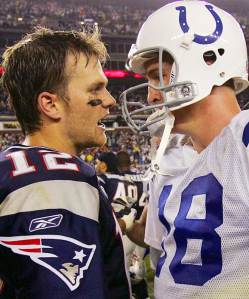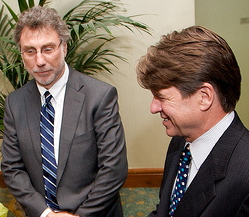My journalism class required me to choose a columnist, follow him by writing weekly in a blog, and then schedule an interview that would wrap up the assignment.
So, I’ve been preparing for this day for 8 weeks and it had finally come.
After a while, I didn’t consider this blog a requirement anymore. Blogging became a part of my weekly routine and learned to love and enjoy every moment of it.
I thought I had learned all I could know about Shaughnessy by reading his columns on a weekly basis, but that assumption was proved wrong after today’s interview. There was clearly a lot more to Shaughnessy than what I could see online or in print paper.
Of course this morning had to be snowing and raining making my travels less pleasant and making me more nervous. Thoughts kept running through my mind. What if I didn’t get there on time? Is he going to be friendly?
As I quickly walked several blocks to the Globe building, trucks sped past me soaking up my jeans. By the time I got there, my feet were numb from the cold, my hair had changed slightly, and I was dripping water drops from every inch of my face. I asked the receptionist where the nearest bathroom was.
I needed to get my act together. A good journalist tip: get there earlier than you are expected. The 20 minutes I had to gather my thoughts and dry off, were crucial. I was ready.
What made traveling in bad weather worth it was the fact that Shaughnessy was inviting, easy to talk to, and most importantly, willing to share all the information I needed.
The interview went better than I could have possibly imagined. I had a list of questions ready to go, but didn’t even completely answer one because he took me in a whole different direction.
How could 8 weeks of preparing for this interview take me into a whole different direction?
Simple.
Shaughnessy and I didn’t have a traditional interview. We had something better than that. We had a casual conversation that opened the discussion to topics and issues that were way more interesting than the ones I had planned.
And so I just went with the flow.
I went in thinking I was going to focus on sports and if that topic fits into “news” category. Right at the beginning we both established that it was. And that was the end of that story.
So we went on to talk about the explosion of Boston.com. I asked, “What do you think about the online version of the Boston Globe?” He answered, “Well, I guess the craft of writing isn’t important any more…people want instant information”.
We had a long conversation about the differences and similarities of online and print newspapers and literally pulled up Boston.com and a newspaper in front of us. It was interesting to see that some of the headlines were the same and some were slightly altered. Not one picture remained the same and what was on the front page online, was on the fourth or fifth in paper.
I remembered talking about original content and “shovelware” in class the other day and this was a perfect way of analyzing critiquing this concept.
Shaughnessy mentioned how kids my age were only interested and involved with online news and didn’t have a problem with saying that the newspaper in print will be long gone very soon.
I was surprised to hear this because others have expressed some hope for the future of print journalism, but he was pretty convincing as he backed up his argument with saying that “people are going to lose their jobs quickly” because my generation is only focused on the World Wide Web.
In the future he sees newspapers becoming really expensive and as a “vanity”, something that only older people will buy.
Then we started talking about his job in more specific details and I asked about his relationship with the major league sports teams. Since he is a columnist and is entitled to his opinions, he said that he doesn’t make it a point to become close with the sports players.
Why? Because he speaks of the “larger truths”. This is why “deep blog fans” don’t like what he writes about sometimes, but he says that just writing on the surface about a win or loss isn’t enough. That kind of writing, “bores him”; therefore he digs deeper.
This is something I applaud him for because he accomplishes reaching a larger audience. Whether or not people like what he has to say, they still are compelled to reading his work. He has my eyes glued to the page and I had no interest in sports prior to reading his columns. Isn’t that a job well done?
We then jumped to talking about his relationship with the sports editor at the Globe. There were only great things he said about him and their connection.
He explained how his editor usually never interferes with his interests and subjects he wants to pursue that day. He says his editor is a “big supporter” and he is very “lucky” to have someone who loves what he does.
Now how does he know what topic he is going to write about? Shaughnessy explained how he flips through the newspaper of the day before and finds something that is a hot topic and then goes from there finding a new angle to take.
Today his deadline was around 7 or 8 at night. He said, “And I still don’t know what I’m writing about”.
The one thing he said in the interview that really stuck to me was when he said, “I’ve had a million guys hate me”. This was in the context of what its like being a sports columnists who sometimes have to cover touchy subjects. He gave an example…when David Ortiz of the Boston Red Sox was caught taking steroids. He said, “I keep distance from those guys because of that type of news” that has to be covered.
By the end of our conversation, he took me on a short tour of the Boston Globe. He personally introduced me to Mr. Baron, the editor of the Globe. We talked for a bit on why I was interviewing Shaughnessy and I was surprised by the natural conversations we were all having as if we’ve spoken before.
I cannot say enough how much this project has enhanced my understanding of sports journalism and writing in general. It was truly a pleasure to follow someone who is so highly thought of in the industry. This was an experience that I will never forget because I am now more open-minded about sport news.
To conclude this whole project, I will come back to the conversation that we had the beginning of course year.
Should sports be considered news?
From my close studies and observations, Shaughnessy did a wonderful job of writing to audiences that reached far more people than just sport fans. He managed to show the economic, political, and social connections that sports news has to the larger world.
So, to answer my own question, yes.
People who don’t agree, I strongly urge that they taking a closer look at sports news. It is a fascinating topic and has interesting columns that take you beyond just the surface on sports.


